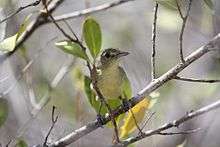Mangrove vireo
The mangrove vireo (Vireo pallens) is a species of bird in the family Vireonidae.
| Mangrove vireo | |
|---|---|
 | |
| Scientific classification | |
| Kingdom: | Animalia |
| Phylum: | Chordata |
| Class: | Aves |
| Order: | Passeriformes |
| Family: | Vireonidae |
| Genus: | Vireo |
| Species: | V. pallens |
| Binomial name | |
| Vireo pallens Salvin, 1863 | |
Description
A drab olive or olive-grey bird, the mangrove vireo has yellow lores and two white wing bars. Sexes are similar. It is approximately 10 cm (3.9 in) long.[2] There are two disjunct populations of this vireo: Caribbean and Pacific. The Caribbean population has both yellow and grey colour phases, while the Pacific population has no colour phases.[3]
Subspecies
There are 10 known subspecies:[3][4][5][6]
- V. p. angulensis (Parkes, 1990): The Bay Islands of Honduras.
- V. p. browningi (A. R. Phillips, 1991): Southeastern Nicaragua.
- V. p. nicoyensis (Parkes, 1990): Peninsula and Gulf of Nicoya, Costa Rica.
- V. p. ochraceus (Salvin, 1863): Pacific mangroves from Oaxaca to El Salvador (Sometimes lumped with V. p. paluster).
- V. p. olsoni (A. R. Phillips, 1991): Parts of Belize.
- V. p. pallens (Salvin, 1863): Honduras and Nicaragua.
- V. p. paluster (R. T. Moore, 1938): Pacific mangroves from Sonora to Nayarit (Sometimes lumped with V. p. ochraceus).
- V. p. salvini (Van Rossem, 1934): Yucatan Peninsula, Mexico and adjacent islands.
- V. p. semiflavus (Salvin, 1863): Southernmost Campeche, southernmost Quintana Roo, Belize, Guatemala, and Honduras.
- V. p. wetmorei (A. R. Phillips, 1991): Eastern-most Guatemala.
Range and Habitat
It is found in Belize, Costa Rica, El Salvador, Guatemala, Honduras, Mexico, and Nicaragua. Its natural habitats are subtropical or tropical dry forests, subtropical or tropical mangrove forests, and subtropical or tropical dry shrubland. The Pacific population is restricted, as the name suggests, to mangroves, while the Caribbean population occupies a wider range of habitats.
Status
The IUCN has classified this species as being of Least Concern.[1]
References
- BirdLife International (2012). "Vireo pallens". IUCN Red List of Threatened Species. 2012. Retrieved 26 November 2013.CS1 maint: ref=harv (link)
- Garrigues, Richard; Dean, Robert (2007). The Birds of Costa Rica. Zona Tropical. pp. 224–225. ISBN 978-0-9705678-5-7.
- Parkes, K.C. Carnegie Museum of Natural History; Section of Birds (1990). "A revision of the Mangrove Vireo, Vireo pallens (Aves: Vireonidae)". ots.ac.cr/. Organization for Tropical Studies. Retrieved 19 January 2014.
- "Mangrove Vireo (Vireo pallens) Salvin, 1863". http://avibase.bsc-eoc.org/. Retrieved 19 January 2014. External link in
|website=(help) - "ITIS Standard Report Page: Vireo pallens". https://www.itis.gov/. ITIS. Retrieved 19 January 2014. External link in
|website=(help) - "Richmond Index -- Infrageneric". zoonomen.net/. Alan P. Peterson, M.D. 15 December 2013. Retrieved 19 January 2014.
External links
| Wikimedia Commons has media related to Mangrove Vireo. |
| Wikispecies has information related to Vireo pallens |
- BirdLife species factsheet for Vireo pallens
- "Vireo pallens". Avibase.

- "Mangrove Vireo media". Internet Bird Collection.
- Mangrove Vireo photo gallery at VIREO (Drexel University)
- Mangrove Vireo species account at Neotropical Birds (Cornell Lab of Ornithology)
- Interactive range map of Vireo pallens at IUCN Red List maps
